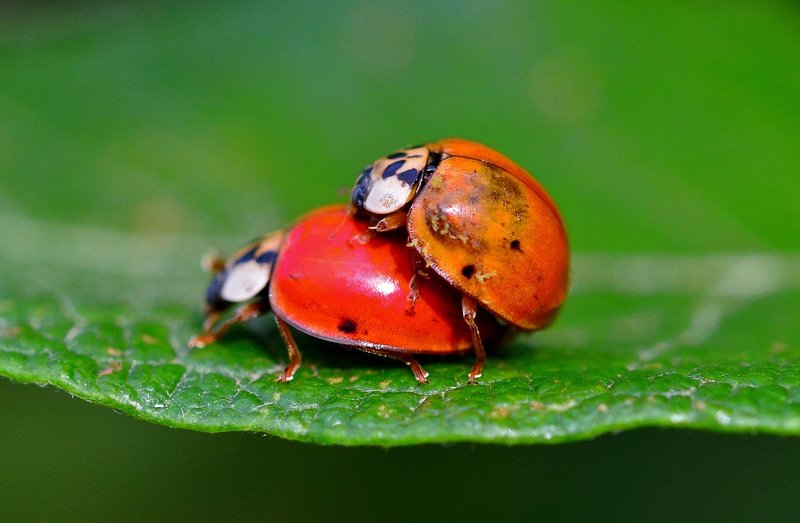
Imagine being surrounded by vibrant flowers and green leaves, the sun shining overhead, and there, on a petal, are ladybugs exchanging greetings. Their methods might not be as straightforward as ours, but they certainly have their charm. Let’s dive into how these tiny insects connect and what it all means for their survival and social life.
The Basics of Ladybug Communication
Ladybugs primarily rely on chemical signals, known as pheromones, to communicate with each other. These are like invisible messages sent through the air—or even left behind on leaves. When a ladybug releases pheromones, it can signal a range of emotions or intentions. For instance, a ladybug might communicate that it’s found a food source, warning others that “Hey, there’s a feast here!”
Moreover, ladybugs also use tactile communication. This means they often touch each other, especially when they want to mate. When one ladybug finds a suitable partner, it may gently nudge or tap the other using its antennae. This physical touch is crucial, as it helps them establish a connection and ensures that both are ready for mating.
Here’s the thing: ladybugs are not just solitary creatures. They love socializing, especially when it’s time to find food or reproduce. Their interactions enhance their chances of survival, as they can share information about food sources or warn one another about predators.
The Role of Pheromones
Pheromones play a huge role in how ladybugs communicate. These chemical signals are released from specialized glands and can carry various messages depending on the context. For example, some pheromones attract other ladybugs to areas rich in food, while others can act as alarm signals when danger is near.
When a ladybug encounters a threat, such as a predator, it quickly releases alarm pheromones. This not only warns nearby ladybugs but can even prompt them to flee from the area. Imagine being at a party, and someone suddenly shouts that there’s a fire. Everyone would quickly scatter! In the same way, ladybugs can react swiftly to danger through their chemical signals.
Interestingly, pheromones can also be species-specific. This means that ladybugs of different species may not understand each other’s chemical messages. Think of it like speaking different languages. If a ladybug meets one from another species, they might not get the intended message!
Visual Signals and Body Language
Ladybugs also communicate visually, using their colors and patterns. The bright red or orange shells with black spots are more than just pretty designs—they send signals to other animals. These colors serve as a warning that they might be toxic or unappetizing, a strategy known as aposematism. Predators learn to associate these bright colors with a bad taste, keeping ladybugs safer.
When ladybugs interact, you might notice subtle movements. They wave their antennae or shift their positions. Such gestures can signal interest or readiness to mate. For instance, when a male ladybug finds a female, he might perform a little dance, moving in circles to attract her attention.
Understanding these visual cues can help us appreciate ladybugs more. It’s almost like watching a ballet, where each movement serves a purpose in their dance of communication.
Sound Communication Among Ladybugs
You might not realize it, but ladybugs can communicate through sound too! They produce soft sounds by rubbing their wings together, known as stridulation. This is a less common method compared to pheromones and visual cues, but it helps them interact, especially during mating.
The sounds may be faint to our ears, but for ladybugs, it’s an essential part of courtship. When a male ladybug wants to attract a female, he sings his love song through these delicate sounds, creating a sort of musical invitation. It’s like serenading someone under the stars, just that in the insect world, it involves a bit more wing action!
This aspect of their communication showcases how diverse ladybug interactions can be, combining chemical, visual, and auditory signals.
The Importance of Social Interactions
So why does all this communication matter? Well, it’s essential for their survival. Ladybugs are social insects, and their interactions help them find food, mates, and avoid predators. When they congregate in groups, they can share valuable information, increasing their chances of finding the best food sources.
When ladybugs team up, they can also provide safety in numbers. If a predator approaches, the bright colors of a group can deter them, as the predator recognizes the potential risk of getting a taste of those unappetizing ladybugs.
In addition, their social life impacts their reproduction. By communicating effectively, ladybugs can ensure their species continues. A well-timed signal can lead to successful mating, helping them populate their habitats.
Ladybugs are fascinating little creatures with a surprising depth to their communication habits. From pheromones that whisper sweet nothings to visual cues that raise alarms, they have a rich social life that ensures their survival.
Understanding how ladybugs communicate not only helps us appreciate these tiny beetles but also highlights the complexity of nature. So next time you see a ladybug, take a moment to watch its interactions. You might find that there’s much more happening beneath those colorful shells than you’d ever imagined.

